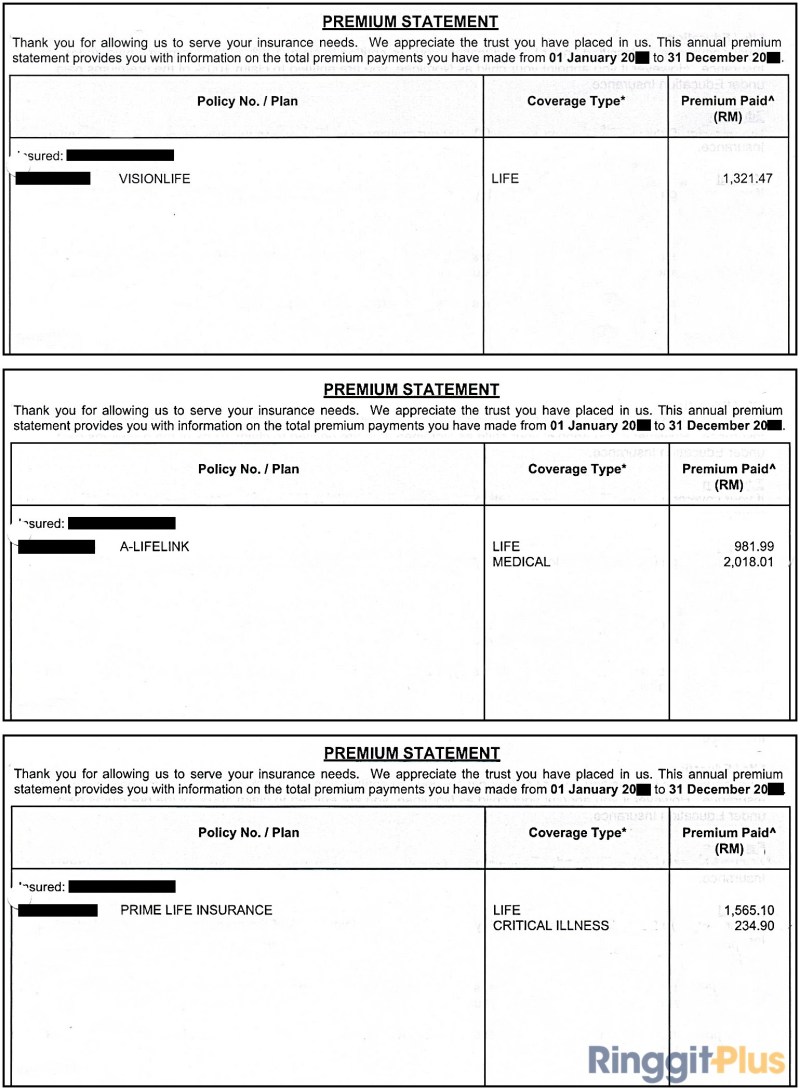Insurance Premium In Profit And Loss Account – Insurance is a financial product sold by insurance companies that protect people (and businesses) from losses or unexpected damage. The insurance companies are able to offer this product by spreading personal risks from a large group of people, so if something bad is happening to a person, such as a difficult car accident, the insurance company helps cover the cost of repairs or replacement. In exchange for payment of insurance premium, people receive greater financial security, knowing that they will not deal with the significant financial charge.
The main financial reports of the insurance companies are the same as the other companies: (1) balance, (2) profitability report and (3) cash flow account. Each of the financial statements provides important financial information to the internal and external stakeholders of an insurance company.
Insurance Premium In Profit And Loss Account

Note that the balance is the first financial situation in the list above. This is different from how we usually detail the financial statements. Indeed, as a financial institution, the activities of insurance companies and income countries are greatly motivated by their balance sheets, more than ordinary companies that manufacture goods or physical services.
How Independent Agents Can Manage Insurance Profit Sharing Volatility
This does not mean that the balance is the only financial situation that determines. Like all other companies, financial analysts use the three basic financial statements to analyze the results and health of the insurance companies.
It is essential to understand the financial health of the insurance companies, not only for the companies themselves, but also for investors, regulation organizations and the wider economy. This is also important for insurance companies, who want to be sure that the company can respect its obligations when accidents occur.
The “buoyancy” of an insurance company is a very important issue for understanding and is essential for understanding the business model of an insurance company.
Float refers to the reimbursement paid by customers to insurance companies. These funds are not immediately paid as insurance complaints. Instead, insurance companies use buoyancy to invest in securities to generate location revenue. Contrary to banks, which will sometimes pay interests for controls, insurance companies usually do not pay interest on customers to customers. For this reason, the insurance premiums actually provide a low or even free funding source for the insurance company.
9) Out Of Insurance Premiumprepare Necessary Accounts And Balance44. ..
The insurance receives a database of insurance premiums paid by police owners, and creates the buoyancy. The flooding is then invested by the insurance companies to generate additional income, usually using bonds, shares and other assets.
When the insured has submitted insurance complaints for covered events such as accidents or substantive damage, the insurance company uses Float money to pay for these complaints. And by dividing risks in a large group and premium investments, insurance companies promise that they have financial resources to fulfill their obligations to insured while receiving investment returns to maintain their activities and develop their business.
Because it is very difficult to provide complaints, the insurance companies must have proper reservations for complaints. This is both a practical demand and regulatory requirement. These reservations are in the form of capital or capital.

Capital serves as a database against larger than expected losses. The appropriate quantity of the shares buffer is determined by the regulatory authorities as well as by the internal modeling of the insurance company.
Final Accounts With Adjustments
As in the past, it is very difficult to predict the claims. Even after an accident, he can take some time before the insurance company announces. In addition, the insurance company will usually want to investigate any complaint to ensure that they are suitable, covered and non -fraudulent. Due to these factors, the insurance company is difficult to assess the expenses related to complaints. However, the insurer must do this in order to meet the principle of correspondence.
For this reason, insurance companies must assess reasonable complaints and record it as an expense on the income report. This assessment is known to be reported (IBNR). Because it is an estimate, it will eventually be adapted or decreased in accordance with the commitment to the commitment.
When reporting complaints, they are some of the causes of claim caused. The combination of this with IBNR reveals the total cost of complaints in a given account period.
The insurance field works similarly to the air transport industry, by paying in advance for a future service. The general principle of bookkeeping is to allocate premiums during the policy period and not immediately after the police are sold.
Pare Trading, Profit & Loss Account And Balance Sheet From The Following..
As discussed earlier, the insurance companies receive bonuses long before they were paid in complaints. In the meantime, insurance companies will invest, which are flooded with different investments to earn income or profits. Although specific bookkeeping can be changed according to investment, many investments are measured at fair value. This means that if these investments are about, the insurance company will present unrealized profit in the profit report. Of course, if the investments are dropped, it will result in a loss that is not paid.
Note that not all investments have an impact on the income report. Some unrealized profits or losses are located in a place that is counted in other global income.
Insurance companies must be maximized so that they can respond financially for any complaint. As part of this, insurers must maintain proper capital reserves and generally invest in regular income investments.

Fixed income investments, especially high -grade duties such as government debts and companies, usually provide stable and expected returns. The visible cash flows of the bond allows you to guarantee that available funds must be paid when complaints must be paid.
Allowance For Doubtful Accounts Explained
In order to develop the company and ensure that they are able to pay complaints, insurance companies must be profitable. The profits can wear the form of subscribers and profit. It would be as far as it was, the profitability increases capital, ensuring that the insurer can respect its financial obligations.
Insurance is in the risk of risk, so good risk management is essential for insurance companies. Important risk management to ensure repayment and financial stability, a complete understanding of the risk of various complaints (and the correct pricing of these risks), regulatory compatibility and maintaining customer trust and reputation, among other aspects.
An insurance company can be analyzed according to some of those metrics we will use during a regular operating company analysis. For example, you can calculate the shares in the same way as any other company. However, there are also various financial relationships specific to insurance. Some of the most common include the following elements:
The loss ratio: The loss ratio is calculated by the distribution of losses caused by the premiums. The higher this, the higher the profitability of the insurance subscription and vice versa.
Firms Want Insurance Companies To Pay “loss Of Profit” Due To Covid-19
The expense ratio: The expense ratio is calculated by the distribution of costs involved in purchase, subscription and bonuses of bonuses by the premiums. As the loss ratio, the lower the ratio, the better.
Integrated ratio: This ratio is calculated by taking expenses directly related to the production of insurance premiums and by dividing these expenses by winning at a certain period. Alternatively, the combined ratio can be calculated by adding the loss ratio to the expense.
In other words, the combined report formula is (fees + expenses + complaints) / bonuses. The higher this attitude, the less profitable the company when it is enrolled in the insurance policies (and vice versa). Any income (or removal)) is not included in this calculation, so even a combined ratio of 100% and above does not necessarily mean that the insurer loses money.

Subscriber ratio: The subscription ratio is simply less integrated. If the combined report is 95%, the subscription ratio is 5%(1 to 95%). In other words, after all subscribers, complaints and fees, the insurer won 5% of premiums.
Prepare Departmental Trading And Profit And
Thanks for reading the CFI in the insurance company’s financial statements. To continue promoting your career and skills, the following CFI resources will be useful:
Control of shortcut shortcuts shortcuts for computers and Mac of Excel Excel shortcuts – it may seem slower at first if you are used to the mouse, but worth the investment to take the time and …
Financial modeling instructions CFI Financial Instructions Full and full model instructions of resource model, model building stones and current advice, tips, …
Types of SQL data which are SQL data? The built -in query language (SQL) includes several different types of data that allows it to store different types of information …
3 Prepare Trading And Profit Loss Account
Built -in application language (SQL) What is the built -in language of application (SQL)? The built -in query language (called SQL) is a programming language used for interaction with a database ….
The upgraded subscription upgrade gives you access to our vast collection of operating plug models designed to feed your performance, as well as the full CFI course catalog and qualified certification programs.
Get unlimited access to more than 250 productive models, the full CFI course catalog and qualified certification programs, hundreds of resources, expert opinions and support, the possibility of working with real financing and research tools and more. Account – Profit and Losing Account | Accounts 11: Chapter 12: Final Accounts of Owner Only – I

A profit and loss account of the benefit and losses is the second part of the income report. This is a nominal account in nature. Commercial entity wants to know not only the rough profit or loss, but also the network













